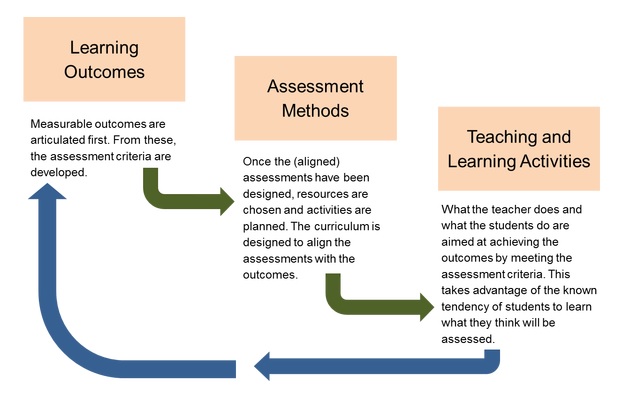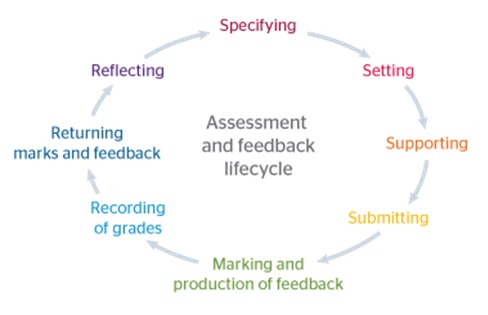Assessment
“Assessment drives learning”
The assessment method will determine for a large part if and how students engage in teaching and learning activities. Any teacher will probably recognize questions such as “Is this part of the exam?’’
Initially this sounds as a negative element. However, it can be beneficial if used in a constructive aligned manner. Hence, the assessment method (a) stimulates to participate in the teaching and learning activities, and (b) measures to what extent the intended learning outcomes are achieved. Constructively aligned assessment requires at least three quality criteria:
- Validity
- Reliability;
- Transparency.
These quality criteria are in line with the criteria that the Nederlands-Vlaamse Accreditatie Orgaan (NVAO) states in its framework for evaluating assessment.
Validity means that the exam measures knowledge, skills and attitudes in a relevant and balanced way, in line with the ILOs. In other words, overall, the type and content of the assessment in all the courses is aligned with the stated intended learning outcomes of the course in the curriculum.
UM good practice: Faculty of Law
To ensure the validity, the exam is judged by a referent before it takes place. The referent is a content expert but has not helped to establish (a part of) the exam. In addition, advice on the validity of the exam can be requested of the assessment advisor of EDIT. The Board of Examiners will check after each course period according to the assessment evaluations, if the content and level of the exam is aligned with the content and objectives of a course.
This aspect of assessment indicates the degree to which the exam measures consistent, fair and stable. In other words reliability refers to the consistency or repeatability of the measurements that exams are. Reliability indicates how certain we can be about the information obtained regarding the exam results.
In other words: an exam with high reliability means that good students succeed in the exam and less good students don’t. There is a fair succeed-respectively fail chance.
UM good practice: Faculty of Health, Medicine and Life sciences
In all multiple choice exams an item-analysis is calculated indicating the reliability of each item compared to the exam as a whole. This analysis is used to inform decisions regarding the withdrawal of an item from the exam in order to improve the reliability of the whole exam.
Transparency is the extent to which all stakeholders – teachers/trainers, learners, assessors, administrators, Board of Examiners – know and understand what is required in the assessment, how the assessment tasks represent intended learning outcomes, and how the students’ work or performance will be graded and marks awarded.
UM good practice: Faculty of Health Medicine and Life sciences
At FHML, assessment practices are specified in so called ‘assessment plans’ (toetsplannen) per course (block, module or educational unit). Assessment plans, as implemented at FHML, describe the connection between intended learning outcomes, teaching and learning activities, and assessment tasks. Assessment plans furthermore clarify standard setting procedures and grading criteria, requirements to pass the (course) exam; criteria and procedures for resits; and general rules and regulations that apply to course tests or exams. Assessments plans are drafted by the examiners responsible. After incorporation of any feedback from the Board of Examiners, a final version is published in Student Portal/EleUM before or at the start of the course. An example of an FHML assessment plan can be found HERE.
Assessment design: part of course design

Assessment cycle
Specify Individual Assessment methods
Number of assignment tasks/assessment methods: Sustainable, feasible, doable, focused on workload
Type of assignment: coursework or examination. Examinations have specific regulations of their own.
The specification should say which of the course learning outcomes are covered by each assessment method/exam question, as well as which of the programme outcomes are addressed.
Weighting of the task/assessment method, as a percentage of the total for the unit. Any combination is acceptable. The decision is tied up with that about the size of the assignment.
Method of Assessment: a one or two word description of the task.
Description: This section should have a short explanation of what students are expected to do, including the expected size of the assignment and any particular requirements, e.g. group work, special submission techniques or specialist resources needed. A peer reviewer or a student should have a clear sense of what is expected from reading this description.
Assessment matrix or also called specification table
Summary can contain e.g.: Submission instructions, Learning outcomes, Assignment details, Size, Penalties for overlong submissions, Marking criteria, Feedback, Support arrangements, etc.
Produce a summary for each assessment method/ assignment within the course (which may be included in the course book).
Ensure that the summary is verified by a colleague before it is shared with students (is everything clear? etc.)
Provide information in course books about how and when to seek support from the coordinator/ tutor(s)
Be familiar with the range of services available to support individual students if needed
- Ensure that students have adequate information about submission arrangements
- Submission regulations.
- Produce a marking scheme for their course, based on the original plan
- Ensure that marking and feedback are completed within the deadline
- Review the marking and feedback process
- Archiving
- Review the profile of grades (and report back to the programme director?)
The return of marked work and feedback will depend on the type of the assignment, as well as on the type of feedback being used. This should form part of the feedback plan made when the assignment is set.
Check if students have received grades and feedback.
There are two parts to reflection on each assessment method:
- Encouraging students to reflect on their own performance and make themselves a personal action plan for the future
- Tutor reflection on the effectiveness of each part of the assessment cycle from setting to the return of work.
Review the effectiveness of assessment methods annually and report back as part of continuous monitoring and improvement.
Encourage students to reflect on their previous assessment performance before beginning a similar assignment, even if in a different unit and at a different level.
I am text block. Click edit button to change this text. Lorem ipsum dolor sit amet, consectetur adipiscing elit. Ut elit tellus, luctus nec ullamcorper mattis, pulvinar dapibus leo.

